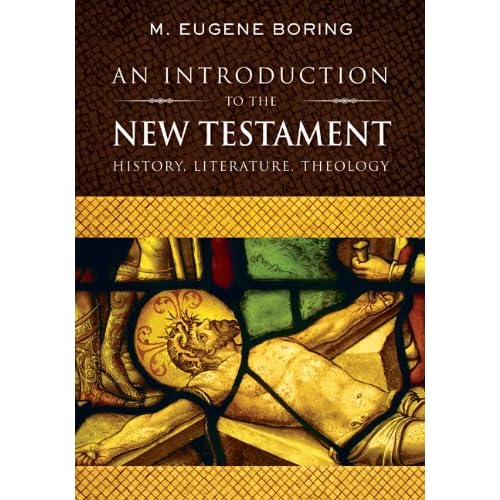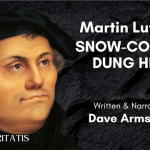
Last year, 2012, was a unique publishing year in that the academy saw no less than 3 NT introductory books published – one by WJK (Boring), one by Baker (Hagner), and one by Oxford (Witherington). I wish to do reviews of all three of these, but reviews of introductions (much like commentaries) are difficult and could be quite boring and tedious. So, I have decided to focus my “review” on 10 key questions, beginning with the WJK volume by Eugene Boring.
- 1. How is the Book Organized?
This paperback textbook is a hefty 700+ pages of double-column text and relatively small font size (though sensibly readable). It is broken down into 28 sections.
What is the NT?
Formation of the NT
Textual Criticism
Translation of the NT
The Interpreted NT
The NT within the Hellenistic World
Palestinian Judaism within the Hellenistic World
Jesus within Judaism
Jesus to Paul
Paul and His letters
Letters of the Early Aegean Mission
Paul and the Corinthians
Paul’s Last Letters
Ephesus and the Pauline School
Colossians, Ephesians, 2 Thessalonains
The Pastorals and the Struggle for Paul
Rome and the Consolidation of Traditions
James, Jude, 2 Peter
From Jesus to the Gospel
Mark and the Origin of the Gospel Form
Interpreting Mark
Interpreting Matthew
Luke: Theologian, Composer, Historian
Interpreting Luke-Acts
Johannine Community and Johannine School
Letters from the Johannine Community: Revelation, 1-3 John
Interpreting the Gospel of John
Epilogue: The NT as Word of God
- 2. Is it Designed as a Textbook?
Absolutely yes. Not only is the print in double columns, but there are numerous images (grayscale), charts, and textboxes. I give Boring’s work an A+ for style.
- 3. Does it Include any Hermeneutical and Canonical Discussions?
As far as canonical discussions are concerned, Boring talks about the formation of the canon, but does not discuss “canonical criticism” per se. Regarding hermeneutics, Ch. 5 (“The Interpreted NT”) offers a nice overview of the history of the study of the NT throughout the centuries. Also, at the end of the book, there is a helpful discussion of the Bible as “Word of God” which includes topics such as revelation and the doctrine of Scripture in the history of the church and in various church traditions.
- 4. What are the Key Interpretive Trends in the Book?
Boring is very historically minded. He spends a lot of time on what was going in the first century. He follows many tradition historical-critical trends of thought: such as starting with Paul and moving to the Gospels later as they seem to be written later (hence, Gospel of John is the penultimate chapter, chapter 27). That doesn’t mean he is not theological. The subtitle of the book is: “History, Literature, Theology.” Also, when he gets into individual texts, he always has a section called “Exegetical-Theological Precis” – he clearly sees exegetical interpretation as not removed from theological interpretation. Still, it appears that, for Boring, these key categories (history, literature, and theology) are truly separate boxes and can be examined on their own.
- 5. Is there a Wider “Theme” in the Book?
For a textbook as eclectic as this, it is hard to pin the book down to one theme, but if I had to choose, I might say “The New Testament as the Church’s Book” (see ch 2). For as historically-minded Boring is (historical context, diachronic analysis of texts), he book ends the textbook with matters that concern how the church should use and make sense of Scripture.
- 6. Are Sectional Bibliographies Up-To-Date and Helpful?
I chose, as my case studies, to look at Romans and the Gospel of John.
On Romans, he includes 6 titles: Barth, Dunn, Jewett, Kasemann, Keck, and Wright. This seems fine to me, especially given Boring’s interests. He might have added Hultgren (2011), but it may have appeared too late to make his list.
As for John, he includes a number of titles (13 in all), the most recent being Warren Carter (2006) and Craig Keener (2003). I was disappointed not to see Gail O’Day or Andrew Lincoln on his list. Ramsey-Michaels was probably too late again for his bibliography. Still, no red flags here and he chose items that will resonate with his own interpretative tendencies.
- 7. Will This Book Appeal to Conservatives, Liberals, or Moderates?
I think it is pretty clear that Boring is a moderate. Let’s take the case of the words of Jesus in the Gospels. In chapter 19, he makes the case that readers of the Gospels should not have overly rigid expectations that the disciples and apostles reproduced the exact words of Jesus. Rather, the genre and attitude towards referencing demonstrates a kind of looseness in quotation. Also, Boring argues, the Evangelists, as storytellers, were permitted by genre and culture a kind of “literary creativity.” Thus, Boring believes the Gospels tell us much about the historical Jesus, but are certainly they are not communicating with uninterpreted facts.
- 8. Is It Too Advanced in Terminology, Depth, and Method for Introductory Students?
The book is certainly too advanced and thorough for freshman undergrads, but I think it could be suitable for serious seminary students. Its size and length are daunting, but it is very well organized, and individual sections are broken down well into bite-size portions.
- 9. If A Student Wanted to Become Knowledgeable in the NT, would This Book Come to My Mind as a Recommendation?
Yes, I think I would recommend this book for those who want a comprehensive introduction to the NT.
- 10. How Does This Book Stack Up Against Green/Achtemeier/Thompson, Powell, LT Johnson, and Carson/Moo?
I think this book is a serious contender in the “NT Introduction” business. I think it would compete best with Luke Timothy Johnson’s Writings. It is the same kind of paperback, B & W Style.
Conclusion
There were some parts of the book that did not appeal to me – such as discussion of a “Johannine Community” or endless pseudepigraphical and partitionary theories for Pauline letters. So, I wouldn’t use this myself as a textbook, since there are some key exegetical pieces that I would have to re-explain to my own students. However, his bookend sections (historical background, canon, history of interp) are all superb. I think those of us who teach intro courses would do very well to have this book at hand for preparation and for our own refreshers, especially regarding socio-historical context.















